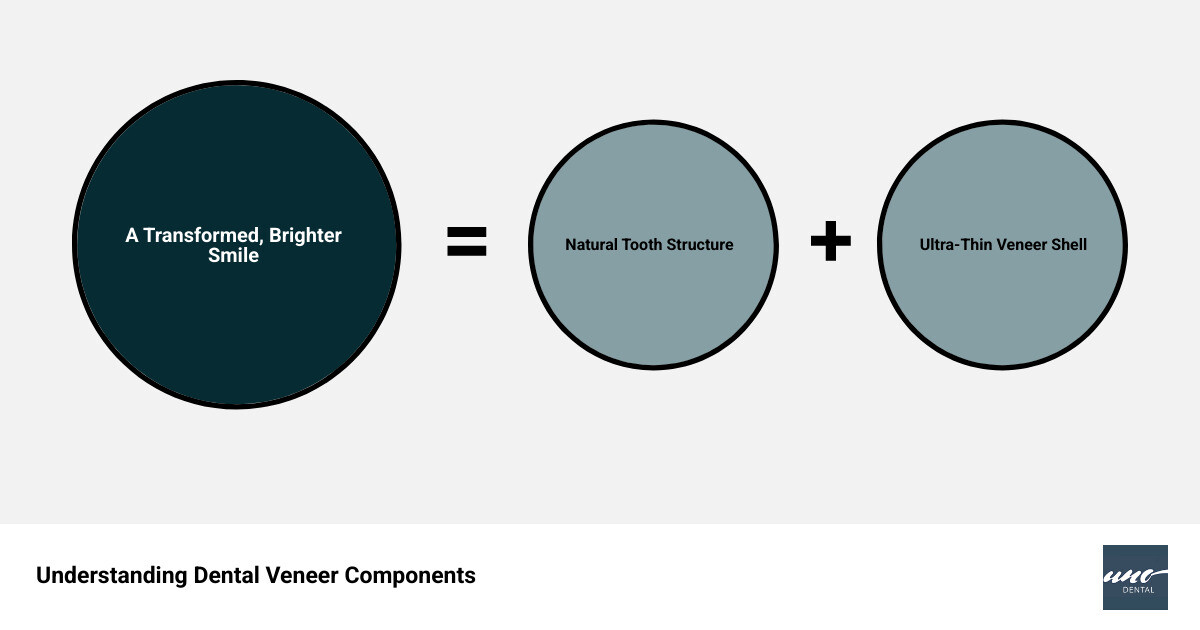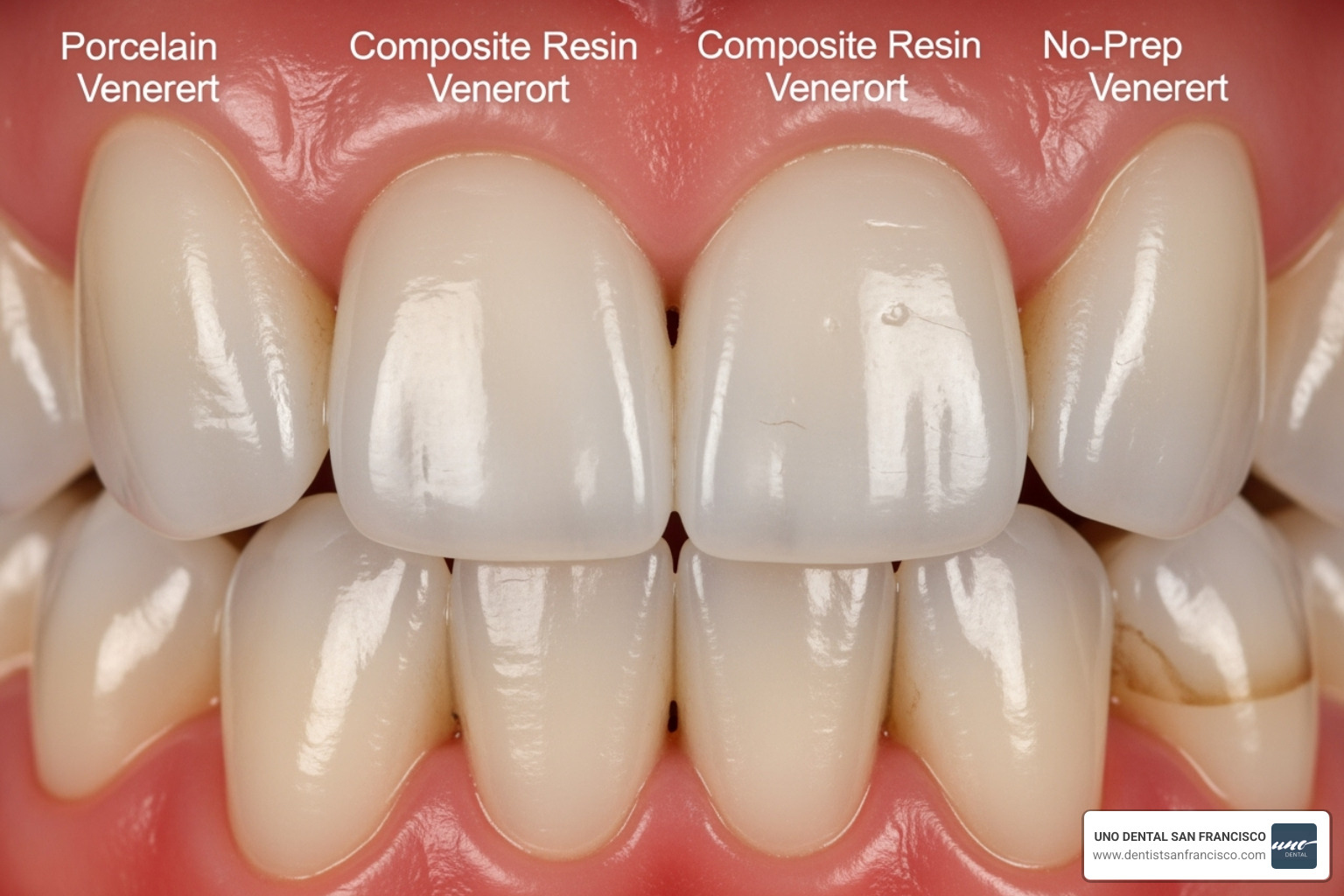
What Are Dental Veneers?
Dental veneers are ultra-thin, custom-made shells bonded to the front surface of your teeth. They are used to improve your smile's appearance by correcting issues like discoloration, chips, gaps, or minor alignment problems.
Veneers are a cosmetic upgrade that can change the shape, size, and color of your teeth, resulting in a more uniform and brighter smile.
I'm Dr. Mohammad Aghiad Kandar, and with over 15 years of experience, I specialize in creating custom treatment plans involving dental veneers at UNO DENTAL SAN FRANCISCO, where we prioritize patient-focused care.
Dental veneers vocab to learn:
Understanding Your Options for Dental Veneers
Considering dental veneers is an exciting step toward your ideal smile. At UNO DENTAL SAN FRANCISCO, we use veneers to boost confidence by blending art and science to craft natural-looking smiles that complement your features.
Our process begins with careful smile design and treatment planning. We collaborate with you to select the best materials and create a personalized plan, ensuring your new smile meets your vision. Understanding your options is key to our personalized care. Learn more about our cosmetic services.
Types of Veneers: From Porcelain to No-Prep
The ideal type of dental veneer for you depends on your aesthetic goals, budget, and the health of your natural teeth. We offer a variety of choices to find the perfect fit for your smile.
Let's explore the main types:
-
Porcelain Veneers: Often called the "gold standard," these are custom-made from high-quality ceramic in a dental lab. They are highly durable, stain-resistant, and mimic the natural translucency of tooth enamel for a lifelike appearance. With proper care, they can last 10 to 20 years or more. Traditional porcelain veneers require removing a small amount of tooth enamel for a perfect fit.
-
Composite Resin Veneers: Also known as "bonding," these veneers use a tooth-colored resin applied and shaped directly onto your teeth, often in a single visit. They are less expensive than porcelain and require minimal enamel removal. However, they are less stain-resistant and durable, lasting about 5 to 7 years, and can be more prone to chipping.
-
No-Prep Veneers (like Lumineers or Vivaneers): These are ultra-thin porcelain veneers requiring little to no enamel removal, making the process less invasive and sometimes reversible. They are ideal for minor cosmetic fixes, like small gaps or shape improvements, and last about 5 to 7 years. Their thinness can make them less durable than traditional porcelain veneers. At our San Francisco dental office, UNO DENTAL, we often prefer eMax material for its biocompatibility and natural transparency, which helps avoid an artificial look.
-
Removable (Snap-On) Veneers: These custom-made coverings fit over your existing teeth and are not permanently bonded. They offer a quick, affordable way to hide cosmetic issues but may not look as natural or offer the protection of bonded veneers. Their long-term safety is still under research, so professional dental guidance is recommended.
The Pros and Cons of Dental Veneers
It's important to weigh the advantages and potential drawbacks of dental veneers before making a decision.
The benefits of choosing dental veneers include:
- Whiten Your Smile: Porcelain veneers are highly stain-resistant, offering a permanent solution for discoloration that whitening can't fix.
- Fix Minor Cosmetic Issues: They effectively cover chips, breaks, gaps, minor misalignment, and can reshape small or misshapen teeth.
- Replace Damaged Enamel: Veneers can act as a protective shield, replacing worn or eroded enamel that doesn't grow back.
- Natural Look: Expertly crafted veneers mimic the look and feel of natural teeth, blending seamlessly with your smile.
- Gum-Friendly: The materials used are generally well-tolerated by gum tissue, causing minimal irritation.
- Durable Solution: Veneers offer a more durable and long-lasting solution for cosmetic concerns compared to bonding.
It's also important to be aware of the potential downsides:
- Irreversible Procedure: Traditional veneers require removing a thin layer of tooth enamel, making the process permanent.
- Potential Tooth Sensitivity: Temporary sensitivity to hot and cold may occur after the procedure but usually subsides. More info.
- Higher Cost: Veneers, particularly porcelain, are a significant financial investment.
- Can Be Damaged: Though durable, veneers can chip, crack, or loosen, especially with habits like teeth grinding. Damaged veneers often require full replacement.
- Cannot Be Whitened: The color of veneers is permanent and does not respond to whitening treatments. Whiten natural teeth before getting veneers.
- Underlying Tooth Can Decay: The natural tooth under the veneer can still get cavities, especially at the edges, making oral hygiene critical.
Are You a Good Candidate for Veneers?
Determining if dental veneers are the right choice is a key step. While they can fix many cosmetic issues, they aren't for everyone.
You may be a good candidate for veneers if you have:
- Good Oral Health: Free of major cavities and active gum disease.
- Sufficient Tooth Enamel: Enough enamel is needed for the veneers to bond securely.
- Cosmetic Concerns: Issues like chips, gaps, stains, worn or misshapen teeth.
- Realistic Expectations: A clear understanding of what veneers can achieve.
Veneers may not be suitable if you have:
- Severe Decay or Gum Disease: These must be treated first.
- Insufficient Enamel: Not enough enamel for a strong bond; crowns may be a better option.
- Teeth Grinding (Bruxism): This habit can damage veneers. It must be addressed, often with a nightguard, before treatment.
- Major Alignment or Bite Issues: Orthodontics like braces or Invisalign are better suited for these problems.
- Large Fillings: A crown may be needed for strength if a tooth has a large filling.
At UNO DENTAL SAN FRANCISCO, our free virtual and in-person consultations help determine if veneers are right for you. We'll assess your oral health and goals to recommend the best treatment plan.
The Veneer Journey: From Consultation to Final Smile
The journey to a new smile with dental veneers is an exciting, patient-centered process at UNO DENTAL SAN FRANCISCO. We combine high-tech tools with a holistic approach, guiding you from your first visit to your final smile.
It begins with an initial consultation to discuss your smile goals and perform a thorough oral health check-up. Next is treatment planning, where we use digital smile design technology to plan the precise look of your veneers and show you a preview of your new smile. The process involves tooth preparation, placing temporary veneers while your custom ones are crafted, and a final appointment to bond your permanent veneers, completing your smile change.
The Step-by-Step Dental Veneers Procedure
Getting dental veneers typically involves a few visits to ensure a precise and lasting result. Here’s a breakdown of the process:
-
Diagnosis and Treatment Planning: We discuss your goals and perform a full exam with X-rays to ensure veneers are the right choice. Using digital smile design, we plan your treatment and show you a preview of the results.
-
Tooth Preparation: For traditional veneers, we remove a thin layer of enamel (about 0.5mm) from the tooth's front surface under local anesthesia. This ensures the veneer fits naturally. This step is minimal or skipped for no-prep veneers.
-
Impressions: We take precise impressions of your prepared teeth using either molds or a digital scanner. These are sent to a dental lab where your custom veneers are crafted, which takes about 1 to 2 weeks. We may place temporary veneers to protect your teeth during this time.
-
Bonding: At your placement appointment (under 2 hours), we first check the fit and color of your custom veneers. Your teeth are then cleaned and etched to create a strong bonding surface. A special cement is applied to the veneer, which is placed on your tooth and hardened with a curing light, securing it in place.
-
Final Adjustments: We remove excess cement, check your bite for comfort, and make any final adjustments to ensure a perfect fit and feel.
Veneers vs. Crowns and Implants: What's the Difference?
Understanding the differences between dental veneers, crowns, and implants is key to choosing the right treatment for your smile.
Here's a clear comparison:
| Feature | Dental Veneer | Dental Crown | Dental Implant |
|---|---|---|---|
| Purpose | Primarily cosmetic; improves appearance | Restorative; strengthens and protects damaged tooth | Replaces a missing tooth (root and crown) |
| Coverage | Covers only the front surface of the tooth | Covers the entire tooth structure | Replaces the entire tooth, from root to crown |
| Tooth Structure | Preserves most natural tooth structure | Requires significant reshaping of the tooth | Replaces the missing tooth and is surgically placed |
| Thickness | Approx. 0.5-1 mm thick | Approx. 2 mm thick | N/A (replaces whole tooth) |
| Invasiveness | Minimal enamel removal (traditional) to none (no-prep) | More invasive; significant tooth reduction | Surgical procedure; post placed into jawbone |
| Reversibility | Generally irreversible (traditional); some no-prep reversible | Irreversible | Irreversible |
| Candidacy | Healthy teeth, minor cosmetic flaws | Damaged, decayed, or weakened teeth | Missing tooth, healthy jawbone |
Dental veneers are a cosmetic solution. These thin shells are bonded to the front of teeth to improve their appearance, making them a less invasive option.
Dental crowns are a restorative solution. They cover the entire tooth to restore strength and function to a damaged or weakened tooth. While also cosmetic, their primary purpose is protection.
Dental implants replace missing teeth entirely. A titanium post is surgically placed in the jawbone to act as a root, and a crown is attached on top. Implants are a permanent solution for tooth loss, restoring both look and function. For more detailed information, you can visit Dental Implants.
At UNO DENTAL SAN FRANCISCO, we will explain these options to help you choose the best procedure for your needs, whether it's cosmetic, restorative, or a tooth replacement.
Lifespan, Care, and Cost of Veneers
Thinking about dental veneers is a fantastic step towards a dazzling smile! But just like any great investment, your new smile needs a little love and understanding to truly shine for years to come. At UNO DENTAL San Francisco, we want you to feel completely confident and informed about the journey ahead, from how long your veneers will last to what they might cost.
How Long Do Veneers Last and How Do You Care for Them?
The lifespan of your dental veneers depends on the material and your oral care. Porcelain veneers are the gold standard, lasting 10 to 20 years or more with proper care. Composite veneers are more budget-friendly but have a shorter lifespan, typically 5 to 7 years.
To maximize the life of your veneers, follow these care tips:
- Practice Excellent Oral Hygiene: Brush twice daily with a soft-bristled brush and non-abrasive toothpaste, and floss daily. This prevents cavities on the underlying tooth, especially at the veneer's edge.
- Schedule Regular Dental Checkups: Visit us for cleanings every six months, or as recommended. Professional cleanings remove plaque buildup at the veneer margins and help us catch issues early.
- Avoid Hard and Sticky Foods: Don't bite on hard objects like ice or pens, and avoid using your teeth as tools. Chew hard foods with your back teeth to protect your veneers.
- Wear a Nightguard or Mouthguard: If you grind your teeth (bruxism), a custom nightguard is essential to prevent damage. Wear a protective mouthguard during contact sports.
- Limit Staining Foods and Drinks: While porcelain is stain-resistant, the bonding agent and adjacent teeth are not. Minimize coffee, tea, and red wine, or rinse with water after consumption.
- Use ADA-Approved Products: Choose dental care products with the ADA Seal of Acceptance for proven safety and effectiveness.
Breaking Down the Cost: Veneers and Insurance
The cost of dental veneers is quoted per tooth and varies based on several factors. Porcelain veneers range from $900 to $2,500 per tooth, while composite veneers cost between $400 to $2,000 per tooth. No-prep veneers are similarly priced, from $800 to $2,500 per tooth.
Factors that affect the price include:
- Material: Porcelain is more expensive than composite due to its durability, aesthetics, and lab fabrication process.
- Number of Veneers: The total cost depends on how many teeth are treated, often six to eight for a uniform smile.
- Geographic Location: Costs vary by region, and our San Francisco prices reflect the local market.
- Dentist's Expertise: The dentist's skill and the quality of the dental lab affect the price. Our team at UNO DENTAL provides top-tier results.
- Case Complexity: More complex cases requiring additional prep work can increase the cost.
Because dental veneers are typically considered a cosmetic procedure, they are rarely covered by dental insurance. Patients should expect to pay out-of-pocket. In rare cases, such as repairing a tooth damaged in an accident, insurance may provide partial coverage. We recommend contacting your provider to understand your policy.
At UNO DENTAL San Francisco, we believe a confident smile should be accessible. We are transparent about costs and offer individualized plans. To make care more affordable, Explore our GleamBar Membership for affordable care.
Frequently Asked Questions about Dental Veneers
We understand that you might have many questions when considering dental veneers. Here are answers to some of the most common inquiries we receive:
Are dental veneers permanent?
Yes, traditional dental veneers are considered a permanent, irreversible treatment. To ensure a natural fit, a thin layer of tooth enamel is removed. Since enamel does not grow back, the tooth will always need a veneer or other restoration to protect it. Some "no-prep" veneers require little to no enamel removal and may be reversible. We can discuss the best option for you during your consultation.
Can you still get cavities with veneers?
Yes. While the veneer itself cannot decay, the underlying tooth is still susceptible to cavities, especially at the margin where the veneer meets the tooth. A cavity can compromise the bond and require the veneer to be replaced. This is why excellent oral hygiene, including brushing, flossing, and regular dental checkups, is crucial for protecting your investment and your natural teeth.
Can veneers be whitened?
No, dental veneers cannot be whitened. The color of porcelain or composite resin is permanent and does not respond to whitening agents. For a uniform, bright smile, we highly recommend whitening your natural teeth before you get your veneers. This allows us to perfectly match the veneer shade to your newly brightened teeth. Whitening after placement will create a color mismatch.
Conclusion: Achieve Your Dream Smile
Dental veneers offer a powerful way to transform your smile, boost your confidence, and correct cosmetic imperfections. Understanding the types, procedure, and long-term care helps you make an informed decision.
At UNO DENTAL SAN FRANCISCO, we believe everyone deserves a smile they love, and veneers are one of the best tools in cosmetic dentistry to achieve that.
Our patient-centered approach combines high-tech dentistry with a focus on your well-being for a truly personalized treatment. From your free virtual smile consultation to final placement, we ensure your journey is smooth and results in a radiant smile that suits you perfectly.
Ready to explore the possibilities for your smile? Schedule a consultation with the experts at UNO DENTAL SAN FRANCISCO. We're excited to help you achieve your dream smile. To make care more accessible, Explore our GleamBar Membership for affordable care.



